
Dorado is a constellation in the Southern Sky. It was named in the late 16th century and is now one of the 88 modern constellations. Its name refers to the mahi-mahi, which is known as dorado ("golden") in Spanish, although it has also been depicted as a swordfish. Dorado contains most of the Large Magellanic Cloud, the remainder being in the constellation Mensa. The South Ecliptic pole also lies within this constellation.

The Large Magellanic Cloud (LMC) is a satellite galaxy of the Milky Way. At a distance of around 50 kiloparsecs (160 kly), the LMC is the second- or third-closest galaxy to the Milky Way, after the Sagittarius Dwarf Spheroidal (c. 16 kpc (52 kly) away) and the possible dwarf irregular galaxy called the Canis Major Overdensity. Based on the D25 isophote at the B-band (445 nm wavelength of light), the Large Magellanic Cloud is about 9.86 kpc (32.2 kly) across. It is roughly one-hundredth the mass of the Milky Way and is the fourth-largest galaxy in the Local Group, after the Andromeda Galaxy (M31), the Milky Way, and the Triangulum Galaxy (M33).

The Tarantula Nebula is a large H II region in the Large Magellanic Cloud (LMC), forming its south-east corner.
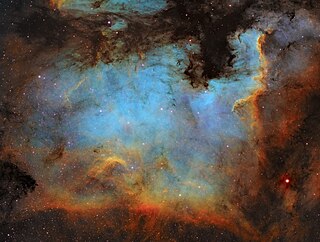
The North America Nebula is an emission nebula in the constellation Cygnus, close to Deneb. It is named because its shape resembles North America.
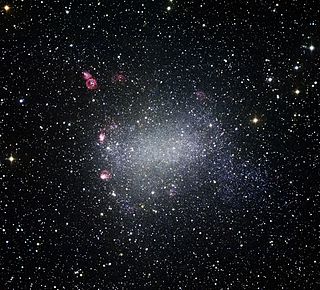
NGC 6822 is a barred irregular galaxy approximately 1.6 million light-years away in the constellation Sagittarius. Part of the Local Group of galaxies, it was discovered by E. E. Barnard in 1884, with a six-inch refractor telescope. It is the closest non-satellite galaxy to the Milky Way, but lies just outside its virial radius. It is similar in structure and composition to the Small Magellanic Cloud. It is about 7,000 light-years in diameter.

Sh2-279 is an HII region and bright nebulae that includes a reflection nebula located in the constellation Orion. It is the northernmost part of the asterism known as Orion's Sword, lying 0.6° north of the Orion Nebula. The reflection nebula embedded in Sh2-279 is popularly known as the Running Man Nebula.
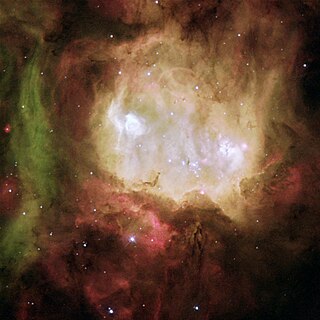
NGC 2080, also known as the Ghost Head Nebula, is a star-forming region and emission nebula to the south of the 30 Doradus (Tarantula) nebula, in the southern constellation Dorado. It belongs to the Large Magellanic Cloud, a satellite galaxy to the Milky Way, which is at a distance of 168,000 light years. NGC 2080 was discovered by John Frederick William Herschel in 1834. The Ghost Head Nebula has a diameter of 50 light-years and is named for the two distinct white patches it possesses, called the "eyes of the ghost". The western patch, called A1, has a bubble in the center which was created by the young, massive star it contains. The eastern patch, called A2, has several young stars in a newly formed cluster, but they are still obscured by their originating dust cloud. Because neither dust cloud has dissipated due to the stellar radiation, astronomers have deduced that both sets of stars formed within the past 10,000 years. These stars together have begun to create a bubble in the nebula with their outpourings of material, called stellar wind.

R136 is the central concentration of stars in the NGC 2070 star cluster, which lies at the centre of the Tarantula Nebula in the Large Magellanic Cloud. When originally named it was an unresolved stellar object but is now known to include 72 class O and Wolf–Rayet stars within 5 parsecs of the centre of the cluster. The extreme number and concentration of young massive stars in this part of the LMC qualifies it as a starburst region.
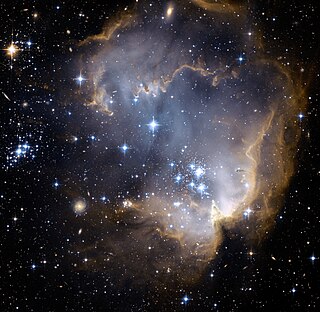
NGC 602 is a young, bright open cluster of stars located in the Small Magellanic Cloud (SMC), a satellite galaxy to the Milky Way. It is embedded in a nebula known as N90.
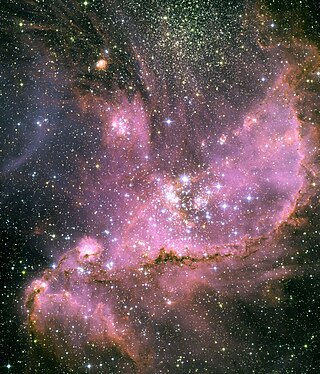
NGC 346 is a young open cluster of stars with associated nebula located in the Small Magellanic Cloud (SMC) that appears in the southern constellation of Tucana. It was discovered August 1, 1826 by Scottish astronomer James Dunlop. J. L. E. Dreyer described it as, "bright, large, very irregular figure, much brighter middle similar to double star, mottled but not resolved". On the outskirts of the cluster is the multiple star system HD 5980, one of the brightest stars in the SMC.

LH 95 is a modestly sized stellar nursery in the Large Magellanic Cloud. It is related to the HII-region LHA 120-N 55, that is, a region of hydrogen ionized by the bright stars of LH 95.

AB7, also known as SMC WR7, is a binary star in the Small Magellanic Cloud. A Wolf–Rayet star and a supergiant companion of spectral type O orbit in a period of 19.56 days. The system is surrounded by a ring-shaped nebula known as a bubble nebula.
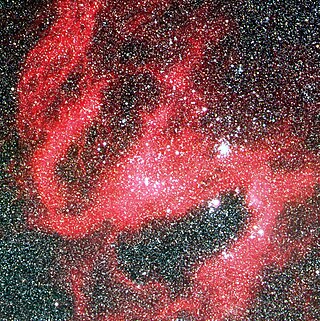
NGC 1910, or LH-41, is an OB association in the Large Magellanic Cloud.
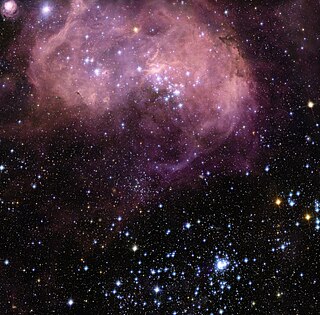
NGC 1763 (also known as N11 B, LH 10 or ESO 85-EN20) is an emission nebula with an embedded star cluster in the Dorado constellation in the Large Magellanic Cloud, It is very bright, very large and very irregular. Its apparent size is about 3.0-5.0 arcmin. It is part of a large region of stars called LMC-N11 (N11) which was discovered with a 23-cm telescope by the astronomer James Dunlop in 1826 and was also observed by John Herschel in 1834. The nebula itself is catalogued under LHA 120-N 11B, LH 10 or ESO 85-EN20. It is also part of an area commonly known as the Bean Nebula.

N119 is a spiral-shaped H II region in the Large Magellanic Cloud. Its dimensions are large, at 131 x 175 pc. It contains several luminous stars including S Doradus, LH41-1042, and LMC195-1. Its peculiar S-shaped structure is difficult to explain with classical models.

NGC 1846 is a globular cluster containing hundreds of thousands of stars in the outer halo of the Large Magellanic Cloud. It was discovered on November 6, 1826 by James Dunlop and is included in the New General Catalogue. At an aperture of 50 arcseconds, its apparent V-band magnitude is 10.68, but at this wavelength, it has 0.07 magnitudes of interstellar extinction.

NGC 2035 is an emission nebula and a H II region in the Dorado constellation and part of the Large Magellanic Cloud. It was discovered by James Dunlop on August 3, 1826. Its apparent size is 3.0.

NGC 2029 is an emission nebula in the Dorado constellation and is part of the Large Magellanic Cloud. It is part of a complex of nebulae and stars, including NGC 2032, NGC 2035 and NGC 2040. It was discovered by James Dunlop on the 27 September 1826. Its apparent magnitude is 12.29, and its size is 2.25 arc minutes.

NGC 1936 is an emission nebula which is part of the larger LMC-N44 nebula located in the Dorado constellation in the Large Magellanic Cloud. It was discovered by John Herschel in 1834 and added to the Catalogue of Nebulae and Clusters of Stars as NGC 1936. It was later observed by John Dunlop on September 27, 1936 and Williamina Fleming in 1901 and added to the Index Catalogue as IC 2127. Its apparent magnitude is 11.60.

NGC 1935 is an emission nebula which is part of the larger LMC-N44 nebula in the Dorado constellation. NGC 1935 is also located in the Large Magellanic Cloud. It was discovered by John Herschel in 1834 and added to the Catalogue of Nebulae and Clusters of Stars as NGC 1935, then was observed by Williamina Fleming in 1901 and later added to the Index Catalogue as IC 2126.
























